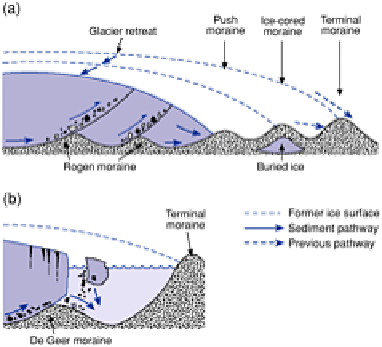Environmental Engineering Reference
In-Depth Information
Figure 15.10
Ice sheet depositional landsystem. Glaciofluvial
(waterlain) and morainic (ice-deposited) subsystems are
shown separately in relation to maximum and retreat stages
but they may, in practice, be superimposed. Both subsystems
are primarily subglacial or ice-marginal in nature and may
be draped with supraglacial sediments (flow and ablation till,
etc.). Extraglacial landforms must be glaciofluvial but ice and
water are both responsible for ice-contact landforms.
Figure 15.11
Moraine formation. Terminal and ice-cored
moraines form passively by debris melt-out from marginal
and buried ice. Rogen and push moraines form under active
ice by melt-out along debris-rich shear planes and episodic
readvance respectively (a). De Geer moraines form by melt-
out from active ice decoupled from its bed in ponded water
(b).
may be indicative of surging glacier behaviour. This would have reactivated terrestrial ice
flow, transferring the zone of deformation into the sediment body in the manner required
for streamlined bedforms.
PERMAFROST PROCESSES AND LANDSYSTEMS
GROUND ICE PROCESSES
Perennially frozen ice lies inert in the ground for the most part, and permafrost includes
adjacent Earth materials, voids and water. Geomorphic activity depends primarily on how

